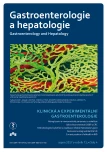Graft-duodenal fistula – a cause of massive gastrointestinal bleeding
Authors:
J. Maceček 1; B. Staňka 1; J. Šťastný 1,2
Authors‘ workplace:
Gastroenterologické oddělení, Nemocnice Prostějov, Středomoravská nemocniční a. s.
1; Chirurgické oddělení, Nemocnice Prostějov, Středomoravská nemocniční a. s.
2
Published in:
Gastroent Hepatol 2017; 71(4): 310-314
Category:
Clinical and Experimental Gastroenterology: Case Report
doi:
https://doi.org/10.14735/amgh2017310
Overview
Pathological communication between the aorta and the digestive tract is a very serious condition, has a high mortality rate, and ranks between a sudden abdominal and a sudden vascular event. The first manifestation is most commonly upper gastrointestinal tract bleeding. Aorto-enteric fistula is a pathological connection between the aorta and the small intestine, most often the duodenum. This is a rare pathological condition that, without acute causal therapy, always ends in the death of the patient. Its early diagnosis, a condition for successful therapy, is problematic. More often, in clinical practice, it is a secondary so-called graft-enteric (duodenal) fistula. Primary aortoenteric (duodenal) fistula is rare and is always associated with aortic pathologies, such as aneurysm or inflammatory changes of the aorta. Equally rare is a connection between a stent graft after previous endovascular treatment of the abdominal aortic aneurysm and the digestive tract. We present a case report of a patient who was successfully diagnosed with a fistula, whose first manifestation was intermittent enterorrhagia, but later progressed to massive bleeding, resulting in an acute operation. Due to the severity of the condition and patient’s age, he died in the early postoperative period. This case points to the importance of a precise disease history, timely diagnosis, and proper diagnostics for successful therapy, which is generally very demanding.
Key words:
enterorrhagia – aortoenteric fistula – graft-enteric fistula
The authors declare they have no potential conflicts of interest concerning drugs, products, or services used in the study.
The Editorial Board declares that the manuscript met the ICMJE „uniform requirements“ for biomedical papers.
Submitted:
4. 5. 2017
Accepted:
8. 7. 2017
Sources
1. Procházka V, Konečný M. Krvácení do horní části trávicího traktu. Postgrad Med 2013; 15 (3): 74.
2. Cameron AJ. Incidence of iron deficiency anemia in patients with large diaphragmatic hernia. A controlled study. Mayo Clin Proc 1976; 51 (12): 767–769.
3. Janík V, Pádr R, Keil R et al. Léčba hemosuccus pancreaticus embolizací obou gastrických tepen. Cas Lek Cesk 2008; 147 (10): 538–541.
4. Svoboda P, Konečný M, Hrabovský V et al. Přínos centralizace péče o pacienty s akutním krvácením do horního trávicího traktu. Vnitř Lék 2012; 58: 191–195.
5. Barry PA, Molland JG, Falk GL. Primary aortoduodenal fistula. Aust N Z J Surg 1998; 68 (3): 243–244.
6. Alzobydi AH, Gurava SS. Primary aortoduodenal fistula: a case report. World J Gastroenterol 2013; 19 (3): 415–417. doi: 10.3748/wjg.v19.i3.415.
7. Başer M, Arslantürk H, Kisli E et al. Primary aortoduodenal fistula due to a swallowed sewing needle: a rare cause of gastrointestinal bleeding. Ulus Travma Acil Cerrahi Derg 2007; 13 (2): 154–157.
8. Cooper A. The lectures of Sir Astley Cooper on the Principles and Practice of Surgery with Additional Notes and Cases by F. Tyrell. 5th ed. Philadelphia: PA Haswell, Barrington and Haswell 1939.
9. O’Brien S, Ernst C. Aorto-enteric fistulas. In: Rutherford R (ed). Vascular surgery. 5th ed. Philadelphia: Saunders 2000: 763–775.
10. Brock RC. Aortic homografting: a report of six successful cases. Guys Hosp Rep 1953; 102: 204–228.
11. Pipinos II, Carr JA, Haithcock BE et al. Secondary aorto-enteric fistula. Ann Vasc Surg 2000; 14 (6): 688–696.
12. Moláček J, Třeška V, Čertík B et al. Aortoenterální a protézoenterální píštěl – závažná náhlá příhoda břišní. Cor et Vasa 2015; 57: 108–114.
13. Marolt U, Potrc S, Bergauer A et al. Aorto-duodenal fistula three years after aorto-bifemoral bypass: case report and literature review. Acta Clin Croat 2013; 52 (3): 363–368.
14. Janne d’Othée B, Soula P, Otal P et al. Aortoduodenal fistula after endovascular stent-graft of an abdominal aortic aneurysm. J Vasc Surg 2000; 31 (1): 190–195. doi: 10.1016/S0741-5214 (00) 70081-4.
15. Grassia R, Staiano T, Iiritano E et al. Gastrointestinal hemorrhage caused by secondary aorto-duodenal fistula: a case report. Eur Rev Med Pharmacol Sci 2009; 13: 147–150.
16. Felt V, Röhling S et al. Neobvyklá příčina krvácení do trávicího ústrojí – píštěl mezi duodenem a aortobifemorálním bypassem. Čes slov gastroenterol 1998; 52 (4): Abstrakt 7.
17. Bergqvist D, Björck M. Secondary arterioenteric fistulation – a systemic literature analysis. Eur J Vasc Endovasc Surg 2009; 37 (1): 31–42. doi: 10.1016/j.ejvs.2008. 09.023.
Labels
Paediatric gastroenterology Gastroenterology and hepatology SurgeryArticle was published in
Gastroenterology and Hepatology

2017 Issue 4
Most read in this issue
- Outcome of treatment of Helicobacter pylori infection based on microbiological susceptibility testing following the unsuccessful second-line eradication treatment
- Acute appendicitis – a rare complication of colonoscopy
- Self-expandable coated metal Danis stent as a bridge to liver transplantation
- Graft-duodenal fistula – a cause of massive gastrointestinal bleeding
